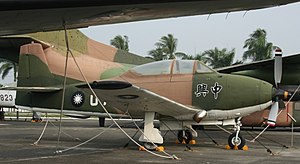Taiwanese trainer aircraft
The AIDC T-CH-1 Chung Hsing[1] (Chinese: 中興) was a turboprop-powered military trainer aircraft produced in Taiwan (Republic of China).
Development
Development of the T-CH-1 began in November 1970. Based on the North American T-28 Trojan training aircraft, the T-CH-1 had a low-wing monoplane design with tricycle landing gear and two seats in tandem. By September 1973, the first prototype had been completed and on 23 November 1973, it made its first flight. A second prototype, able to carry weaponry, was also produced, and completed its first flight on 27 November 1974. Alongside the two prototypes, a further 50 aircraft were ordered for the Republic of China Air Force, with the final aircraft delivered in late 1981.[2][3][4]
Specifications
Data from Jane's All The World's Aircraft 1980–81[5]
General characteristics
- Crew: 2
- Length: 10.26 m (33 ft 8 in)
- Wingspan: 12.19 m (40 ft 0 in)
- Height: 3.66 m (12 ft 0 in)
- Wing area: 25.18 m2 (271.0 sq ft)
- Aspect ratio: 6:1
- Airfoil: NACA 64-2A215
- Empty weight: 2,608 kg (5,750 lb)
- Gross weight: 3,402 kg (7,500 lb)
- Max takeoff weight: 5,057 kg (11,149 lb)
- Fuel capacity: 963 L (212 imp gal; 254 US gal)
- Powerplant: 1 × Avco Lycoming T53-L-701 turboprop, 1,082 kW (1,451 hp)
Performance
- Maximum speed: 590 km/h (370 mph, 320 kn) at 15,000 ft (4,600 m)
- Cruise speed: 310 km/h (200 mph, 170 kn) at 15,000 ft (4,600 m) (econ cruise)
- Stall speed: 93 km/h (58 mph, 50 kn)
- Never exceed speed: 690 km/h (430 mph, 370 kn)
- Range: 2,010 km (1,250 mi, 1,090 nmi) (with maximum fuel)
- Service ceiling: 9,800 m (32,000 ft)
- Rate of climb: 17 m/s (3,400 ft/min)
Related development
Aircraft of comparable role, configuration, and era
